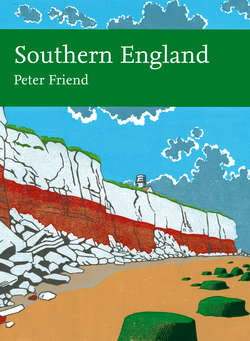Читать книгу Southern England - Peter Friend - Страница 10
LANDSCAPE CHANGE
ОглавлениеWe tend to think of rural landscapes as unchanging features of our surroundings, in contrast to the man-made scenery of cities and towns. Yet we all know of local catastrophes, such as a sea cliff collapsing during a storm, or a flooding river removing its bank and wrecking the nearby buildings, and these are the sorts of local events that do result in change. Despite the excitement, individual changes of this sort are small and can usually be regarded as local modifications. However, over time, the accumulated effects of many such modifications can cause whole landscapes to change.
Size and time clearly both play key parts here. The collapsed cliff or eroded river bank will probably be tens to hundreds of metres long at most, while the larger landscape features picked out in this book are tens or even hundreds of kilometres across. Noting the length scales involved in this way is an important way of keeping such differences clearly in mind.
Moreover, while local events such as the destruction of landforms or buildings may be immediately newsworthy, more long-term patterns of change in the natural scenery are rarely apparent during the life spans of people, and even during the hundreds of years of written records. So it becomes necessary to use indirect and circumstantial evidence – to play the detective – to find out what long-term changes have been going on.
An important step in thinking about the natural landscape is to look at it in terms of modifications to complex surfaces defined by the ground. On land, we tend to be most aware of erosional processes removing material, but it is important to realise that the material removed has to end up somewhere – and this will involve its deposition later, on land or in the sea. How much material was removed from the cliff during the storm or from the banks of the river during the flood? Where did the lost material go, and how did it change the landscape when it was deposited at its new destination? Knowledge of these surface modifications can provide a yardstick that allows us to compare different sorts of changes happening over different periods of time and at different scales, and can help us to work out their relative importance, quoting amounts and rates. For example, a flooding river may remove a hundred metres of river bank, modifying the local landscape a little in the process. However, this modification is unlikely to have much impact on the scenery, unless followed many, many times by similar modifications, over centuries to hundreds of thousands of years. In this way a series of such floods can erode and move material that, in the long run, may be of sufficient volume to significantly change the landscape, for example lowering a hill slope or filling a valley bottom.
The majority of- but not all – surface modification processes act to reduce or flatten topography, mainly by eroding the higher features but also by filling in lower ground with sediment. So logically landscapes might always be regarded as tending towards a flat surface. Our understanding of the processes involved suggests that any land area with mountains or hills will be eroded downwards to an increasingly flat surface as time passes, although the rate of erosion will reduce as the topography becomes more and more smooth. Acting against these flattening processes are periodic movements of the ground surface caused by forces within the Earth, producing new mountains and hills, and so creating new landscapes (Fig. 5).
Continuing research into the processes operating within the Earth shows that movements of the Earth’s crust are taking place continuously, even though the rates involved are generally too slow to be noticeable. The discovery that the Earth’s surface consists of a large number of tectonic plates in continuous relative movement was one of the major breakthroughs in the earth sciences, and has fundamentally changed our understanding of the planet. More on this topic will be considered in Chapter 3, but at this point it is important to realise just how slow the rates of movement are: at most a few centimetres per year on average (often compared to the rate at which fingernails grow). Occasionally, movements of centimetres or metres occur within seconds along faults during earthquakes, but the average rate of movement is still rather slow. Most of us living in stable areas are totally unconscious of any movement at all because we are, ourselves, moving slowly with the landscape that we live on. Slow though the movements may be in a particular landscape, so also are the rates of surface modification, and the balance between the two is a delicate one. In much of Southern England modification by surface processes is dominant, but this has not always been the case.
FIG 5. Landscapes are changed by surface modifications (Chapter 2) and solid earth movements (Chapter 3).
Our next chapter deals with the timescales represented in the landscapes of Southern England and the processes that have been modifying them. Chapter 3 deals with the movements from below – from within the Earth’s crust – that are ultimately creating major landscape patterns.
